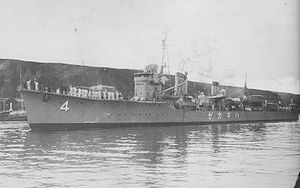Hagikaze (萩風, Clover Wind) was one of 19 Kagerō-class destroyers built for the Imperial Japanese Navy during the 1930s.
 Hagikaze upon commissioning, March 31st 1941.
| |
| History | |
|---|---|
| Name | Hagikaze |
| Builder | Uraga Dock Company |
| Launched | 18 June 1940 |
| Stricken | 15 October 1943 |
| Fate | Sunk in action, 7 August 1943 |
| General characteristics | |
| Class and type | Kagerō-class destroyer |
| Displacement | 2,490 long tons (2,530 t) |
| Length | 118.5 m (388 ft 9 in) |
| Beam | 10.8 m (35 ft 5 in) |
| Draft | 3.8 m (12 ft 6 in) |
| Speed | 35 knots (40 mph; 65 km/h) |
| Complement | 240 |
| Armament |
|
| Service record | |
| Operations: |
|
Design and description
editThe Kagerō class was an enlarged and improved version of the preceding Asashio class. Their crew numbered 240 officers and enlisted men. The ships measured 118.5 meters (388 ft 9 in) overall, with a beam of 10.8 meters (35 ft 5 in) and a draft of 3.76 meters (12 ft 4 in).[1] They displaced 2,065 metric tons (2,032 long tons) at standard load and 2,529 metric tons (2,489 long tons) at deep load.[2] The ships had two Kampon geared steam turbines, each driving one propeller shaft, using steam provided by three Kampon water-tube boilers. The turbines were rated at a total of 52,000 shaft horsepower (39,000 kW) for a designed speed of 35 knots (65 km/h; 40 mph). The ships had a range of 5,000 nautical miles (9,300 km; 5,800 mi) at a speed of 18 knots (33 km/h; 21 mph).[3]
The main armament of the Kagerō class consisted of six Type 3 127-millimeter (5.0 in) guns in three twin-gun turrets, one superfiring pair aft and one turret forward of the superstructure. They were built with four Type 96 25-millimeter (1.0 in) anti-aircraft guns in two twin-gun mounts, but more of these guns were added over the course of the war. The ships were also armed with eight 610-millimeter (24.0 in) torpedo tubes for the oxygen-fueled Type 93 "Long Lance" torpedo in two quadruple traversing mounts; one reload was carried for each tube.[2] Their anti-submarine weapons comprised 16 depth charges.[3]
Construction and career
editWith the start of WW2 for Japan, Hagikaze escorted Admiral Kondō's main body throughout the invasion of the Philippines and Dutch East Indies, before escorting invasion convoys for the same purpose. On February 15, Hagikaze conducted shore bombardment to cover Japanese troop landings, then operated alongside Japanese aircraft carriers for the following months, finally returning to Japan on April 22, where she was docked for maintenance.[4]
Hagikaze escorted Japanese aircraft carriers in what became known as the battle of Midway, during which four Japanese aircraft carriers and a heavy cruiser were fatally damaged by American carrier aircraft. Near the end of the battle, the fatally wounded aircraft carrier Kaga was scuttled by Hagikaze's two torpedoes, Kaga being scorched by US dive bombers from the aircraft carrier USS Enterprise during the battle. Throughout the following months, Hagikaze departed on escorting and transport missions, being damaged by a bomb hit from B-17s which destroyed her X turret, forcing her into repairs for the rest of the year into February 22 1943. Throughout March, Hagikaze operated alongside the escort carrier Chūyō, then escorted the battleships Kongō and Haruna to Truk, before seeing out escorting and transport missions, with an interruption on May 8 when she attempted to assist the crippled destroyers Kagerō and Oyashio, but failed to arrive before they were finished off by land based aircraft, then it was back to escorting and transport missions. On August 2, she took part in a troop transport mission when her consort, the destroyer Amagiri, rammed and sank the US torpedo boat PT-109, commanded by future US president John F Kennedy.[4][5]
On 7 August 1943, Hagikaze was sunk between Kolombangara and Vella Lavella (07°50′S 156°55′E / 7.833°S 156.917°E) during the Battle of Vella Gulf, by torpedoes and gunfire from the US destroyers USS Dunlap, USS Craven, and USS Maury, with 178 killed.
Notes
editReferences
edit- Chesneau, Roger, ed. (1980). Conway's All the World's Fighting Ships 1922–1946. Greenwich, UK: Conway Maritime Press. ISBN 0-85177-146-7.
- Jentschura, Hansgeorg; Jung, Dieter & Mickel, Peter (1977). Warships of the Imperial Japanese Navy, 1869–1945. Annapolis, Maryland: United States Naval Institute. ISBN 0-87021-893-X.
- Whitley, M. J. (1988). Destroyers of World War 2. Annapolis, Maryland: Naval Institute Press. ISBN 0-87021-326-1.
- Hara, Capt. Tameichi (1961). Japanese Destroyer Captain. New York: Ballantine Books. ISBN 0-345-02522-9.